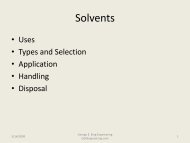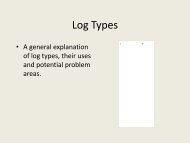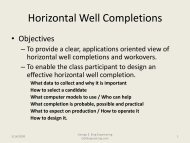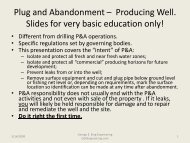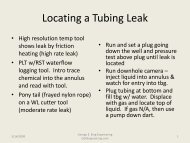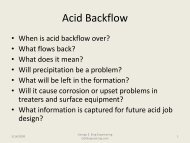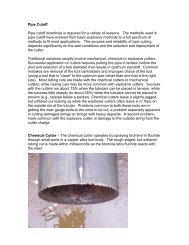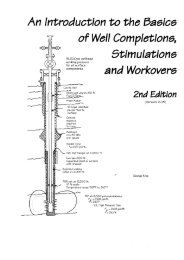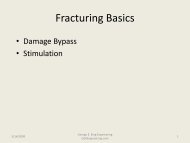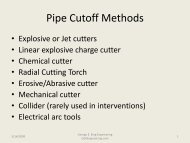Addressing the Environmental Risks from Shale Gas Development
Addressing the Environmental Risks from Shale Gas Development
Addressing the Environmental Risks from Shale Gas Development
You also want an ePaper? Increase the reach of your titles
YUMPU automatically turns print PDFs into web optimized ePapers that Google loves.
Oil and gas drilling generally begins in <strong>the</strong> same way in both vertical and horizontal wells.Operators insert an initial length of steel pipe, called ―conductor casing,‖ into a vertical wellboresoon after drilling begins in order to stabilize <strong>the</strong> well as it passes through <strong>the</strong> shallow, oftenunconsolidated sediments and soils near <strong>the</strong> Earth‘s surface. 5 (See Figure 2.) Then, operatorscontinue drilling vertically and insert surface casing, which most states require to extend <strong>from</strong><strong>the</strong> ground‘s surface past <strong>the</strong> depth of all underground sources of drinking water (USDW‘s). 6Operators <strong>the</strong>n pump cement into <strong>the</strong> casing, followed by water, to push <strong>the</strong> cement out through<strong>the</strong> bottom of <strong>the</strong> casing and back up into <strong>the</strong> space between <strong>the</strong> surface casing and <strong>the</strong> wellbore(called <strong>the</strong> ―annulus‖) until it is entirely filled. Almost all states require <strong>the</strong> surface casing to befully-cemented before drilling is allowed to continue. 7 After <strong>the</strong> surface casing has beencemented into place, regulators may require operators to install blowout prevention equipment(BOPE) at <strong>the</strong> surface to prevent any pressurized fluids encountered during drilling <strong>from</strong> movingup <strong>the</strong> well through <strong>the</strong> space between <strong>the</strong> drill pipe and <strong>the</strong> surface casing. 8Figure 2. Casing and Cementing of a Horizontal Well After allowing <strong>the</strong> cement behind<strong>the</strong> casing to set, operators continuedrilling for a short distance,typically 10 to 20 feet, and test <strong>the</strong>integrity of <strong>the</strong> cement bypressurizing <strong>the</strong> well. They <strong>the</strong>ncontinue drilling vertically untilstate regulations may require <strong>the</strong>insertion of intermediate casing,which can be used to help stabilizedeep wells. In addition, between <strong>the</strong>base of <strong>the</strong> surface casing and <strong>the</strong>target gas-bearing shale formations,wellbores pass through thousands offeet of rock formations. Theseformations may containhydrocarbons, including naturalgas, or briny water containinghighly concentrated salts and o<strong>the</strong>rcontaminants. Intermediate casingis designed to isolate suchSource: GWPC. Not to scale.formations <strong>from</strong> each o<strong>the</strong>r and <strong>the</strong>wellbore, preventing contaminationof <strong>the</strong> gas that will be produced and of freshwater aquifers near <strong>the</strong> Earth‘s surface.When drilling a horizontal well, operators begin turning or ―kicking off‖ <strong>the</strong> drill when <strong>the</strong>y near<strong>the</strong> top of <strong>the</strong> target formation or ―production zone,‖ until <strong>the</strong> wellbore runs through <strong>the</strong>formation horizontally. Horizontal drilling, which can extend up to 10,000 feet, vastly increases<strong>the</strong> wellbore‘s contact with <strong>the</strong> gas-bearing formation relative to vertical drilling, which wouldbe limited to <strong>the</strong> thickness of <strong>the</strong> formation—less than 300 feet in most major U.S. shale plays. 93



